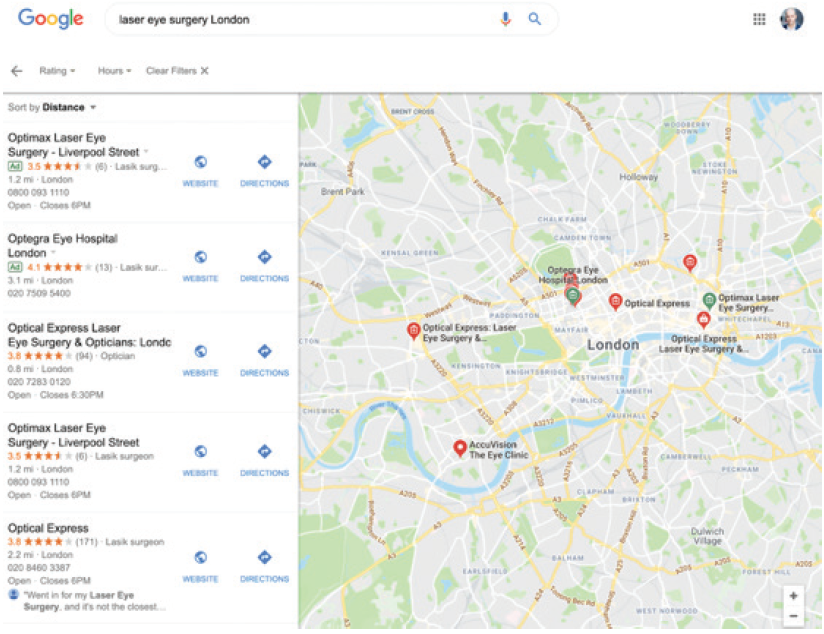

Market positioning refers to the place or niche that a brand occupies in your target patient’s mind and the ways that he or she can distinguish your practice from others. To position your practice or its brand, it helps to understand what positions other practices—your competitors—occupy in the minds of your prospective patients. After reading this article, you will understand how to identify the most relevant competitors in your niche, analyze their strengths and weaknesses, and occupy the gaps that they underserve.
LIST YOUR RELEVANT COMPETITION
Most patients find a new vision correction provider on the internet (ie, through a Google search), so do what they do and start there.
Step No. 1: Plot your target area.
To find your target area, use a map circle tool such as the application from Map Developers (http://bit.ly/0519Solar). If you are in a metropolitan area, plot a circle around your location with a 50-km radius (roughly equivalent to a 1-hour drive). On the other hand, plot a 100-km radius (2-hour drive) for nonurban areas or urban areas with little competition (Figure 1).

Figure 1. A 50- and 100-km radius, here depicted on a map around Cardiff, Wales, can help practices establish their target market.
Step 2: Identify other practices in your target area.
Go to Google Maps and search for something like “laser eye surgery London,” and you will see the list of the providers that most people will see when searching for that query. In a recent search of central London, Google Maps presented a list of 22 providers vying for a laser eye surgery prospect’s attention (Figure 2).

Figure 2. Searching an area on Google Maps will present a list of providers in that area that prospective patients will also be able to find.
These results will tell you who is attracting internet traffic. Only competitors with sufficient online content or Google advertisements will appear on this list. You may also notice that many of the competitors you think of as successful do not appear in this search result. These less digitally oriented competitors are likely getting most of their traffic from offline sources, such as referrals (from patients, optometrists, or insurers) or traditional media channels.
Just as you cannot feasibly attract every laser vision correction prospect, you cannot feasibly compete against every vision correction provider. You must focus on competing in your niche. How do you whittle this list into a meaningful set?
Step 3: Segment your competitors by identifying what patient avatar they try to attract.
As with most tasks in marketing, you need to draft some patient avatars (see our column in the March issue of CRST Europe, “Laser Target Your Market with Patient Avatars”).1 True competitors are not vying simply for any potential patients in your geographic region, they are aiming for the same patient avatar you are.
Once you identify your patient avatar, you need to decide on your market level. A competitor’s pricing often defines its market level, and you can typically find this on the competitor’s website or by calling the competitor’s office. Different market levels will tend to attract different patients:
- The down-market patient avatar is seeking the lowest cost alternative;
- The mid-market patient avatar is seeking a middle-of-the-road solution and value for money; and
- The up-market patient is seeking the best option, even if he or she must pay more for it.
Some of your competitors likely come to mind when you read these descriptions. In other cases, the market level might not be so clear. Competitors define themselves by the markets they seek to attract. If you cannot easily discern who a competitor is seeking to attract, it is likely that the practice has a blurry position in its prospects’ minds. Your job, when positioning, is to be as clear as possible.
Choose only the subset of competitors that seek to attract your targeted patient avatars. Your shortlist will range in number depending on where you practice, but a manageable number is three to five. If you end up with more than five, you should group them further, as one of the following:
- Chains;
- Hospitals offering multiple medical specialties;
- Clinics specializing in ophthalmology; or
- Independent surgeons (itinerant surgeons who work in various locations).
Then, choose the providers (regardless of group type) that compete at your level (down-, mid-, or up-market). The chains, hospitals, clinics, and independent surgeons that compete at your level are your competitors. They—and you—will make up the evoked set of options that your specific patient avatar will likely consider when deciding whose website to visit, who to call, and who to visit for his or her first appointment.
HOW THE MARKET PERCEIVES YOU AND YOUR COMPETITORS
As objectively as possible, you must rate your competitors on the most relevant priorities for your potential customers at the awareness stage of their vision correction journey. You must recognize that your prospective patient knows next to nothing about vision correction. All he or she has is perceptions.
What do prospective patients consider important at this stage? Think of the three As:
- Availability;
- Affability; and
- Ability.
Availability. Because prospective patients have so little to go on, they will first look at your availability. They want to know:
- Is the website fast?
- Is it easy to find what I’m looking for?
- Does this practice offer a solution to my problem?
- Is there a low-commitment offer to learn more if I’m not yet ready to call or book a first appointment (ie, live chat, lead magnets, open evenings, webinars, Skype appointments, free screenings)?
- Does the website share prices?
- Does the website have patient reviews?
- Can I book an appointment online (not just request one, but schedule one)?
- Can I call someone when it is convenient for me?
- How much information can I get over the phone?
- How convenient is it for me to drive to the location?
- Can I access the location by public transit?
- Does this practice offer appointments outside of typical business hours (evenings and weekends)?
- How soon can I schedule an appointment?
- Will I see a surgeon at the first appointment?
- Does the practice offer flexible payment plans for treatment?
Note that prospective patients, at this stage, are not asking about what technologies you offer or whether your results are good—that comes later. At this point, they are gaining impressions of the items above as they browse your website, visit patient review sites, and/or call your center.
Put yourself in your prospective patients’ shoes and audit not only yourself but your competitors’ online presence and phone performances. When we do this for our clients at LiveseySolar, we score clients and their competitors on every factor above using a scale that helps us derive a summary score of all availability measures. Being objective can be difficult. You may know the truth behind the marketing facades, and that might sway your judgements. It is far better for a third party to evaluate these things and provide you with an analysis that is as close as possible to actual patients’ perceptions.
Affability. Before the first appointment, prospective patients must make assumptions about affability from the sources within their reach. These sources include websites, patient review sites, social media, advertising, and phone calls:
- Does the website make it easy to engage with the practice?
- Do the text and images on the website feature the patient as the hero of the story?
- Can I find a sufficient number and quality of patient reviews on third-party sites?
- Do the surgeons appear friendly and caring in videos?
- Does the practice have an engaging social media presence?
- Does the staff seek to understand my needs on the first phone call?
Ability. Finally, most patients will assess a provider’s ability through the only lens they have—their perceptions. You can influence their perceptions by showing the evidence of your ability online and on the phone. Features that signal ability include the following:
- Do you show evidence of a good safety record?
- Do you showcase a safe and effective technology or technique?
- Do you show evidence of specialization? (Expertise can give patients a sense of reassurance that the surgeon is committed to depth in this type of treatment.)
- Do you show evidence of good outcomes? (Most patients are not experienced in interpreting statistical data. They will often infer results from summary data, testimonials, and endorsements.)
- What do your customer reviews and ratings on Google or other sites say?
- Do you operate in a hospital setting? (Patients tend to believe that hospital settings offer more safety and professionalism than other settings.)
QUANTIFYING RESULTS TO FIND PROFITABLE GAPS
Do not make the mistake of rating your competitors based on what you think about them. You may know much more about your competitors than your prospective patients do. For this exercise, you need to put that insider knowledge aside and consider your competitors as if you knew only as much about them as what they portray publicly and what their patients say about them. You also need to quantify what you find.
Using the scores you have calculated for the criteria discussed earlier, you are now ready to plot them against the advertised price per eye that you and each competitor charge for a procedure. For this hypothetical exercise, we have set the prices like so:
- Competitor 1: £1,000/eye;
- Competitor 2: £1,250/eye;
- Competitor 3: £2,000/eye;
- You: £1,000/eye.
PLOT YOUR MARKET POSITIONING
Now that you have quantified how you and your competitors score, you can plot these values to better visualize your market positioning. In Figure 3, competitors’ prices are listed on the horizontal axis, and criteria scores for ability (expressed as percentages) are plotted on the vertical axis. In this example, you are of high relative quality, but not the best. This plot suggests that you are likely underpricing your services on the basis of the evidence of your quality compared with that of your competitors.

Figure 3. In this example of a market positioning chart, your practice is depicted as of high relative quality, but not the best. This plot suggests that you are likely underpricing your services on the basis of the evidence of your quality compared with your competitors.
Alternatively, if you were charging a higher relative price but not showing sufficient evidence of quality, this would be a signal that you need either to show more evidence or to drop your prices to attract more leads on the basis of quality. Repeat this exercise for every priority (ability, availability, and affability).
CHOOSE A NICHE AND SHOW YOUR EVIDENCE
Finally, you can look at the gaps in the chart in Figure 3 and choose your niche. You can choose more than one niche; however, your customer has limited scope for linking more than one position to each brand.
Blurring your focused market positioning by occupying too many niches might not be a sufficiently focused strategy to attract your patient avatar. Once you have objectively defined where you win against your competitors’ perceived availability, affability and ability, it is time to justify your assertions with evidence. List your evidence points for why you should position yourself on each priority. When you do, you will find your most advantageous market niche.
What does evidence look like? Have another look at the evidence we reviewed under each of the priorities that are most important to refractive surgery patients. Every single evidentiary point on which you can demonstrate value is a deposit in the patient’s perceived value account that you can publicly share on your website, on social media, and over the phone. We further advise you to continue providing evidence of these crucial factors that influence patient decision-making across the whole customer value journey.
Ultimately, you want to choose a niche that represents not only a gap in the market but also a niche in which you have the best chance of outshining your competition due to the unique ways that you provide a great patient experience.
It is often the quality of your service, rather than your medical attributes, that defines your niche and helps patients feel emotionally connected to your practice.
1. Solar R, Livesey L. Laser Target Your Market with Patient Avatars. Cataract & Refractive Surgery Today Europe website. March 2019. https://crstodayeurope.com/articles/2019-mar/laser-target-your-marketing-with-patient-avatars/. Accessed May 1, 2019.


